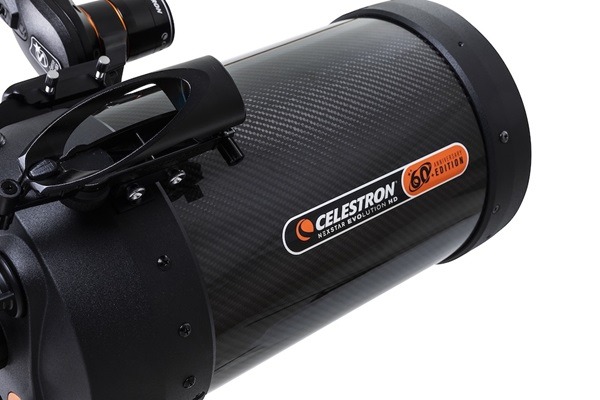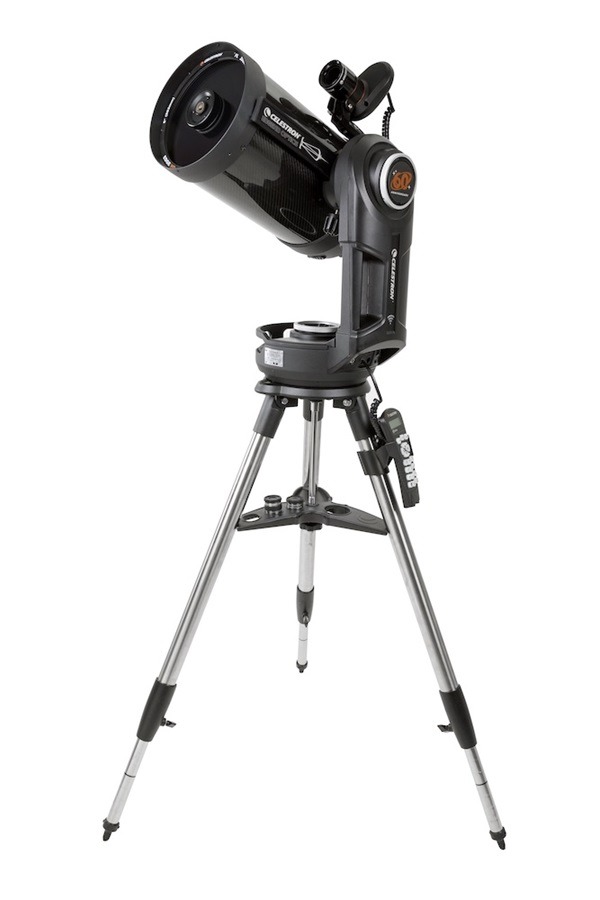
The telescope’s carbon-fiber tube is lightweight and strong, giving this model a high-tech appearance. Credit: Celestron.
This review of the Celestron NexStar Evolution 8HD was first published in the February 2021 issue of Astronomy Magazine. It has been updated and contains affiliate links to the current model of this telescope. When you buy a product through a button on this page, we may earn a commission.
When I was a teenager, new to observing the sky, I spent a year wandering across the Milky Way armed with nothing more than a pair of 7×50 binoculars. Then a miracle happened: I received a Celestron 8, 1976 vintage, as a birthday present. It changed my universe forever.
From the cornfield behind our Ohio subdivision, the telescope opened up completely new vistas — star clusters, nebulae, and galaxies. Not only could I see hundreds of spectacular sky objects, but I was seeing things like the Veil Nebula, which the old-fashioned literature of the time contended was beyond the reach of an 8-inch scope. Now I feel like I have undergone another telescope revolution. Last year Celestron celebrated its 60th anniversary. As part of their festivities, they produced a new 8-inch Schmidt-Cassegrain Telescope (SCT), one that rolls all of the company’s fanciest features into one package.
With a built-in wide-field camera, it aligns itself in a matter of minutes, requiring minimal knowledge on the part of the user. It then slews to any of 40,000 targets within its onboard computer’s database. Its multicoated optics are of the highest caliber, and the three included eyepieces are sensational. This is the ultimate 8-inch SCT of its time, and I was happy to be able to put it through its paces over the past few weeks.

Setup and inspection of the NexStar Evolution 8HD
Assembly was relatively straightforward, and a helpful booklet walks owners through the process. I went slowly, read everything carefully, and within an hour had everything set up in my living room for inspection, charging of the onboard battery, and preparation for a night of observing.
With the telescope assembled, I couldn’t help but be struck by its quality and elegance. It features a carbon-fiber tube; multicoated, high-transmission optics (what Celestron calls “Edge HD”); a sturdy single-arm mount; and, of course, the alt-azimuth mounting enabled by the computer control of the scope. The company seemingly spared no details: The machining is top-notch and the hardware is solid, a 2″ focuser and star diagonal came along with the package, and the tripod is heavy duty. The onboard battery holds a charge for more than 10 hours at a time. The included eyepieces are very nice, with a 2″ 32mm “porthole” for deep-sky observing and higher-power 11/4″ eyepieces of 15mm and 9mm focal lengths.
The StarSense system was really what intrigued me. I am an old-school, star-hopping guy who has taken great pride in learning the sky and finding objects manually for years. Would this computer-controlled system with its database of tens of thousands of objects — which it would apparently use to align itself before hopping between galaxies — win me over?
Out under the stars with the NexStar Evolution 8HD
The first thing you need to do with this scope is set it up on level ground and run a program that enables the StarSense unit to calibrate itself. Included instructions and a link to an online video tutorial make that very simple. That first night I was in a hurry, so I set it up on my driveway to give it a quick run-through. Although a portion of the sky was blocked by a tree and the house, I was curious to see what would happen.
So began my adventure with StarSense Autoalign. The camera mounts atop the scope’s tube with a heavy bracket and plugs into a port on the mount. To begin the calibration procedure, you start with the scope’s tube positioned horizontally. A hand controller allows you to input choices and, once the scope is aligned, target countless objects. I uncorked the scope’s mirror, the StarSense camera’s cover, and the diagonal’s cover before plopping a very nice E-lux 32mm Celestron eyepiece into the diagonal.
I powered the NexStar Evolution 8HD on, chose “Align” on the hand controller, set the time, date, and time zone, then stepped back and watched. Over the course of about 10 minutes, the scope slewed to and fro and occasionally noted on the controller that it had imaged a certain number of stars. Would this work with the handicap I gave it in my rush to test the scope? After a short time, “Alignment complete” came up on the controller.
Next, I followed the protocol by calibrating on a known star. I punched in “Vega” and the scope immediately slewed upward, capturing Vega’s position. When I peered into the eyepiece — low power, no doubt — the star was dead center. The final step is a calibration on the star itself (Vega in my case), and this can be done with a high-power eyepiece to maximize precision. You can then realign the StarSense and, in another few minutes, the mount is ready to use all night; you can simply punch in targets and let the NexStar Evolution 8HD slew to them.
This full calibration procedure needs to be performed only once, when the StarSense Autoalign is first attached to the telescope’s tube. From there, a full calibration is not needed unless the StarSense is bumped or the bracket removed.
Wow. Here is the kind of telescope that could revolutionize astronomy. This is a telescope that anyone can use without any knowledge of old-style polar alignment. It is really quite amazing to see this work just as magically as is advertised, with objects showing up dead-centered, just as requested from the database.
Computer-controlled heavens
I gave this telescope a more thorough test run from my backyard in Wisconsin, where I can see the Milky Way and a good smattering of faint stars. The telescope performed most impressively. I can’t wait to get it underneath a really prime sky like that of southern Arizona.
I commenced my journey with Jupiter and Saturn, each looking really fine, with nice cloud details, even at low power. All the moons that should have been present were, and the higher-power eyepieces provided a splendid view early on, even though the seeing had not fully settled down for the evening.
But I was eager to tour deep-sky objects and so I plopped the 32mm eyepiece back in and went to work. Everything I looked at showcased the quality of the telescope’s optics — the views were crisp and well defined, and I saw all the details in clusters, nebulae, and galaxies that I would expect to see from a suburban site. The 32mm eyepiece provides a sharp, flat field, yielding crisp stars all across the view.
The Lagoon Nebula did not disappoint, with its gauzy areas of bright gray-green nebulosity and the sparkly, well-populated star cluster NGC 6530. For a time, I walked up the line of bright clusters and nebulae in Sagittarius and Serpens. Only needing to input the numbers of Messier and NGC objects makes one spoiled quickly. There was the Trifid, glowing faintly; the unmistakably bright Omega Nebula popped fiercely, and the delicate light of the Eagle Nebula appeared well defined. The computer-controlled database makes punching in some of the lesser-known objects like clusters M23, M25, and NGC 6603 easy. I worked my way up to M11, which was incredible, and then viewed some globulars — M22 in particular was a killer, looking quite photographic.
I turned toward some favorite planetary nebulae I hadn’t viewed in a while. The Dumbbell Nebula, high in the sky, knocked my socks off — it looked like a glowing photo in a rich starfield of colorful suns. What incredible beauty. But Cygnus and Aquila had many other treasures, and I viewed NGC 6781, NGC 6894, NGC 7008, and NGC 6826 (just to name a few). They all appeared quite well defined, with the blue-green colors showing well, and were visible at low powers, growing more spectacular as I increased magnification.
I then took a shot at some widely scattered objects just to see the range of views the telescope could provide. The Andromeda Galaxy appeared bright and oval, with well-defined dust lanes close to the nucleus. The Owl Cluster in Cassiopeia, with its bright deep yellow chief sun, was an old friend I revisited. Double stars like Mizar and Albireo were simply stunning, set in black starfields, and galaxies like M81 and M82 floated majestically in space.
As the night went on, I found this telescope to deliver on everything I had hoped for: The optics are sharp, the accessories luxurious, the tripod overbuilt and very stable, the craftsmanship of the optical tube and the electronics first-rate. I have a soft spot for the old 1976 Celestron 8, with which I made my initial thousands of observations, and which is now in my basement. But there’s a new Celestron in town, and this magnificent model is going to be hard for any such portable instrument to overcome. This is a telescope for a new age of amateur astronomy.

